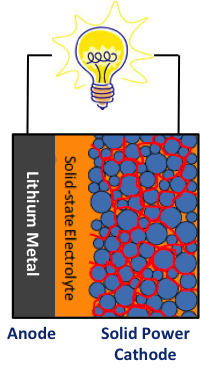In what may be eventual good news for future electric aviators, the U. S. Department of Energy (DOE) Advanced Research Projects Agency – Energy (ARPA-E) will award approximately $36 million to 22 projects to develop transformational electric vehicle (EV) energy storage systems using innovative chemistries, architectures and designs. ARPA-E also uses the term, “revolutionary.”
The series of awards is part of the RANGE program (Robust Affordable Next Generation Energy Storage Systems), intended “to enable a 3X increase in electric vehicle range (from ~80 to ~240 miles per charge) with a simultaneous price reduction of > 1/3 (to ~ $30,000). If successful, these vehicles will provide near cost and range parity to gasoline-powered ICE vehicles, ARPA-E said.”
“Transformational” comes straight from the CAFE phrase book, a hoped-for direction that goes beyond evolution to revolution in what comes next. A 3X battery at 1/3 the price would certainly be transformational, especially in aircraft use, making even ultralights plausible, and Light Sport Aircraft truly functional. Craft such as Pipistrel’s Panthera or Volta Volare would be brilliant in pure electric or hybrid mode with such improved batteries.
Part of the cost reduction would come from a more inclusive approach to battery and system design, improving EV driving range and reducing vehicle costs “by re-envisioning the total EV battery system, rather than working to increase the energy density of individual battery cells.”

Quallion truck battery, 1/4 the weight of a comparable lead-acid battery. Quallion also makes aerospace batteries
Green Car Congress notes that ARPA-E is not interested in incremental changes or “that have little potential to reduce system complexity, weight, and cost.” The University of California at San Diego will receive funding to make lighter, less costly batteries and find ways to incorporate them into the vehicle’s frame, something that involves a multi-disciplinary approach and expansive goals.
ARPA-E has created different categories for funding, with one for batteries varying from advanced aqueous lithium-ion batteries (University of Houston) to a water-based flow battery for EVs (General Electric). Another, involving battery and vehicle architectures, provides funding for “multifunctional battery chassis systems,” (Stanford University), “Low-Cost Electric Vehicle Battery Architecture,” Cloteam LLC, “Multifunctional Battery Systems for Electric Vehicles,” University of California, San Diego, “Multifunctional Cells for EVs,” Arizona State University, “Structural Battery Power Panels,” Pennsylvania State University, and “Impact-Tolerant EV Batteries,” Purdue University.
In the “Robust non-aqueous” category, ARPA-E has provided funding to Quallion for a battery that not only provides thermal and mechanical safeguards to prevent overcharging, overheating, and cell damage, but includes new components to isolate damage and reduce the need for additional packaging and shielding. Funding will also go to the Illinois Institute of Technology for a “nanoelectrofuel flow battery” for EVs that uses a high-energy density liquid as its electrode. This will require increasing the normally low, but stable energy density of such batteries. Taking up a similar challenge, the National Renewable Energy Laboratory (NREL) will devise new ways to use organic energy storage materials. Finally in this category, Oak Ridge National Laboratory (ORNL) will create an electrolyte that changes from liquid to solid when impacted, a novel approach to eliminating shielding that adds weight to conventional batteries.
Three private enterprises and one academic institution will receive funds for research on solid-state batteries. Ceramatec will develop a non-porous, high-conductivity ceramic membrane for lithium-sulfur batteries to minimize self-discharge, provide mechanical integrity, and extend battery life. Their new battery will include advanced electrolytes developed for this system.
Using low-cost, non-flammable, non-volatile materials, Solid Power, LLC will develop a solid-state battery with improved energy density and safety. Bettergy, reaching for the same goals, will create batteries with similar energy density to current offerings, but “enhanced strength and robustness.” Finally, the University of Maryland will work with ceramic materials and multi-layer processes to produce a solid state battery with lower weight and longer life.
ARPA-E’s hoped-for results are short of the 5X, 1/5th current cost battery former U. S. Secretary of Energy Steven Chu asked for last December. Other goals, a bit disparate from those expressed above, would be welcome in the EV community, including $125 per kilowatt hour batteries. Compare that to Electravia’s current prices per kW-hr of about $1,875 to $1,900, and ElectraFlyer’s of about $1,517 to $1,600 per kW-hr. Note these prices include battery management systems and packaging.
We can hope for an improved and broader range of energy storage products coming from this coordinated effort by government, academia and private enterprise, especially with the varied materials and approaches involved.


Comments 2
Units! Units!
Those are not kW/hr. They are kW-hr. (That is, “$1,875 to $1,900 per kW-hr”, etc.)
For a blog where efficiency is a major focus, it undermines your credibility when you mix up your units. It’s not the first time. Maybe a wall poster over your desk?
Power = kW or hp
Energy = kW-hr or GGE (gallons of gasoline equivalent)
Never Use: kW/hr (unless you know what you’re doing, and mean it)
Cheers!
(Editor’s Note: Having been gently, but effectively chided, the offending units have been corrected, and your editor promises greater diligence in the future.)
It’s been pointed out to me that the standard symbol for kWh is… kWh, and not kW-hr.
So that makes 2 of us.
🙂